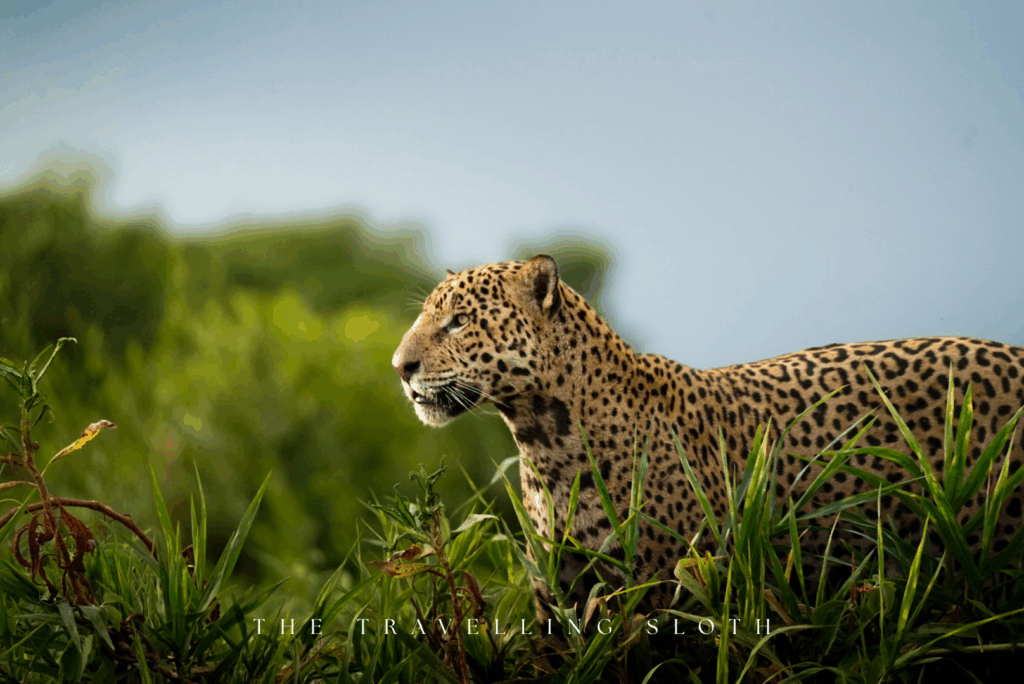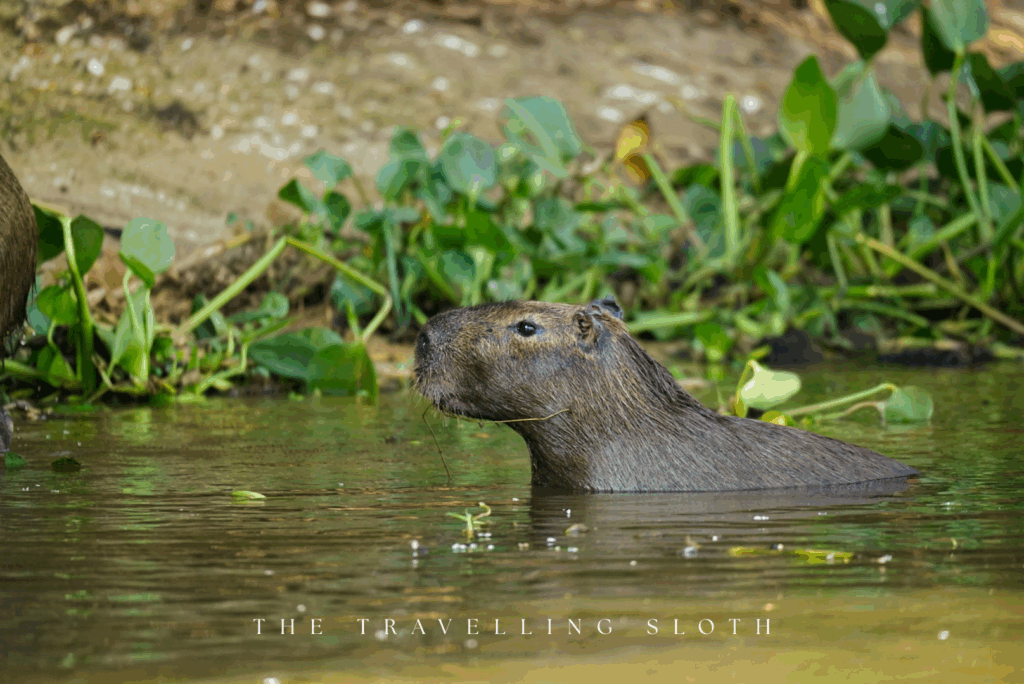I’ll admit – I hadn’t really heard about the Pantanal until a couple of years ago when my husband shared what was on his bucket list. Obviously, curious, I ended up finding more about it and followed some amazingly talented photographers. Really pushed me to want to see it for myself.
While it still feels like one of South America’s best kept secrets – amongst photographers and wildlife enthusiasts… it’s pretty well known. It’s the world’s largest wetland. Some call it the cousin of the Amazon. During dry season, it’s the hotspot for spotting jaguars. Bet that caught your attention 😉 It actually has the highest concentration of jaguars in the world. From my perspective, it’s been one of the most unreal places I’ve visited. Jaguar numbers are healthy and the conditions can align creating amazing shots.
Whether you are visiting solely for the interest of spotting jaguars or if you love wildlife in general, this guide aims to walk you through planning your trip to the North Pantanal in Mato Grosso… I’ll be covering the WHO, WHEN, WHERE, WHAT, HOWs to make it an unforgettable adventure! Because I remember being overwhelmed while planning this trip…
Where is the Pantanal?
It’s located in the Brazilian states of Mato Grosso and Mato Grosso do Sul and extends over into Bolivia and Paraguay. To get to either Cuiaba or Campo Grande, you can fly from São Paulo or a few other cities with any of the regional airlines: Azul, Gol and LATAM.
There’s obviously a couple of key places to know when planning your trip to the Pantanal. There’s Southern Pantanal, accessible via Campo Grande or Northern Pantanal accessible via Cuiaba. As I only had a chance to visit the Northern sector so this is where I will be covering.

Cuiaba: The capital of Mato Grosso. A large city, home to over 1 million people and quite spread out. There are a couple of amazing places to visit nearby, a couple of hours’ drive, such as the Vue Nuevo Waterfall and Villa Bom Jardim which I would recommend visiting if you get the chance.
Transpantaneira Road: This is the stretch of gravel road between Poconé → Porto Jofre. While driving it during dry season, you might spot plenty of wildlife and there are plenty of lodges or pousadas located along it offering a chance at seeing different mammals.
Porto Jofre: This village marks the end of the Transpantaneira Road and is the gateway water access to the river channels where jaguars are known to hunt. There are quite a few operators operating out of here but your best bet is to book them in advance or via the Pousadas.
River Systems: If you’ll be staying at the flotels or in a pousada located nearby the water systems, you’ll probably be taking a boat to explore the different canals – this by far gives you the best opportunity to see jaguars!
Why the Pantanal, Mato Grosso is a Hidden Gem
Okay, so when I say Brazil + Widllife – where do you first think of? I would place my bets on it being The Amazon… Well, allow me to introduce you to the Pantanal. As I mentioned earlier, I hadn’t personally heard of it until a couple of years ago, when my husband introduced it to me. And after talking to the local guides whom have called the Pantanal home for years, I’ve learnt what makes this part of Brazil so remarkable.

1. High density of Jaguars in concentrated areas.
During the dry season, the drying rivers/floodplains push animals towards the water canals making jaguars and other wildlife sightings easier than other times of the year. It was often thought that jaguar territories don’t overlap but it was proven otherwise. You can find overlapping territories since the concentration of Jaguars is so great! We saw 5 jaguars in a space of 200m.
Did you know you’ve a better chance of seeing a jaguar in the Pantanal than in the Amazon?! And which part of the Pantanal matters as there’s a high concentration in the northern sector than the south.
2. Relative solitude & remote vibe.
While exploring the water canals, it can feel wild and undiscovered… especially when you’re the only boat floating down the river. Of course, that can’t be said when there’s an incredible jaguar sighting when all the boats come to the same spot. But apart from that, the region still feels quite off the radar. From a photographer’s perspective, there are plenty of intimate moments with other wildlife and it is silent apart from your camera shutter breaking the silence.
We were even fortunate enough to have a few sightings of jaguars just with our boat.
3. Conservation urgency.
Talking with the guides, it becomes clear how delicate the balance here really is. The Pantanal doesn’t have a single governing body overseeing conservation. Instead, tour operators have created their own system of self-regulation, setting guidelines that protect both visitors and wildlife. Much of the region is privately owned ranch land which adds another layer of complexity.
In 2024, devastating wildfires swept through the Pantanal, burning an estimated 80% of the landscape. You can still see the scars if you look closely. And yet, the recovery is remarkable. New growth is already pushing through, a testament to both the resilience of the ecosystem and the ongoing efforts to preserve the Pantanal’s natural beauty and wild character.
When is the Best Time to Go
Dry Season (High Opportunity Window)
From about early June to November, the wetland starts drying up. All this depends on how much rainfall they’ve had during the wet season. But with the drying of rivers and floodplains, the jaguars start migrating towards the sandbanks and canal edges for hunting opportunities. Giant river otters gather where channels narrow and prey is concentrated. Birds become more visible so great time for birders!
In Mato Grosso, many operators recommend July – October as the peak dry season. Guides repeatedly told me that minor differences in water levels (even a few centimetres) can drastically change where jaguars or caimans appear. Later in the dry season, the weather isn’t as hot… although, don’t get me wrong, it is still high 30s! But on the bright side, there are a lot fewer mosquitoes to annoy you.

Wet Seasons (best avoided)
From December to March, heavy rains come. The area transforms into floodplains and the landscape drastically changes. With the abundance of water everywhere, the wildlife disperses from the easily accessible riverbanks. The access via the Transpanteria Road and navigating the rivers becomes a challenge. With all the rains, the plants grow thick and dense which makes spotting animals really difficult. Majority of the lodges and flotels close for the season.
Also, the transition months (April/May, and sometimes late November) can offer a mix: lower rainfall, still relatively green scenery, fewer guests, maybe some rain. But still, spotting wildlife can be quite a challenge.
Where to Stay – Flotels or Pousadas/Lodges
In my experience, I only stayed on a flotel so I’ll mainly be talking about those.
Flotels: essentially a floating hotel anchored along the river banks. The main advantage here is the immediate access to water and a shorter commute time to where you might find jaguars. It would give you the most time with the animals.
*Stay tuned as I’ll be sharing more about my experience staying on a flotel.
Land lodges or Pousadas: these are primarily to find animals that inhabit the forests and tend to stay further from the water canals. Some pousadas offer jaguar tours on the water but the trade off would be the travel time.
If you want to optimise your time to see jaguars, I would suggest staying at a flotel. However, depending on who you book with, you’ll be able to customise your itinerary so you get both experiences depending on how much time you are there for!

Logistics: Access + Transportation
When you’re visiting Northern Pantanal, you’ll be visiting the Gateway village of Porto Jofre. The closest airport would be Cuiabá (CGB), the capital of the state of Mato Grosso (MT). Most lodges or tour companies provide a pick up either from your accommodation or the airport.
To get from Cuiabá to Porto Jofre, you will take land transportation driving on tarred roads to Poconé. Poconé to Porto Jofre is connected by the Transpantaneira Road, a long gravel road so expect travel time fluctuate depending on weather and road conditions. It took us approximately 5 hrs to get from Cuiaba to Porto Jofre and another 20mins to our Flotel. Depending on your choice of accommodations, the Pousadas are scattered along this road or the flotels, which transport via boat would be provided by the pousadas.
Okay, but how much is a tour to the Pantanal?
Right, so – this ranges. We found some companies offering a day tour from Cuiaba from USD$ 200 per person to multi day-week long! It all truly depends but for the experience we had: staying on a Flotel, all meals included, 2 trips per day out on the water, transportation and for 4D, 3N – it cost USD$1800 per person for the entire package. It may sound quite steep but when you consider how remote this place is and the logistics of trying to see jaguars, it was worth it in my opinion.
*There are different itineraries on offer with several companies – keep an eye out as I’ll be sharing the different options soon.

Since I travelled with Pantanal Safaris (based in Poconé, Mato Grosso) I learned a lot about what makes a good operator:
- Their guides are local, know river behavior well. That means they often know when to stay or attempt to look for another sighting. Our boat driver was part of the National Geographic doco about the Pantanal so you’re pretty certain he knows where to go!
- It was easy to communicate with them and they were prompt at responding to emails, transfers and even flexible with our drop off.
Final Notes
- Don’t expect perfection. Wildlife is unpredictable. Be patient, be ready to adapt gear or plans when nature demands.
- Always photograph ethically. No baiting, no flash close to big cats, respect distance, follow guide instructions.
- Use your images to tell both beauty and story: habitat, threats, conservation, the people who care for this region.
- If possible, return. Each year wildlife behavior shifts slightly. There’s always more to discover.
If you come to photograph the Pantanal, I hope your photos do more than impress… you’ll soon realise you’re capturing fragility, rapid change and gives a voice to conservation. Because even this hidden gem is not immune to climate shifts, deforestation, fires and human land demands.

Leave a Reply